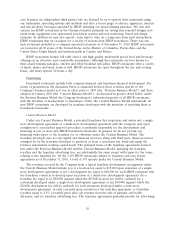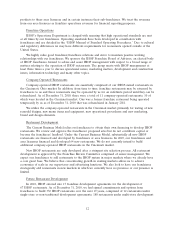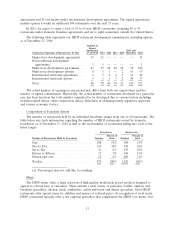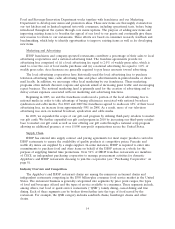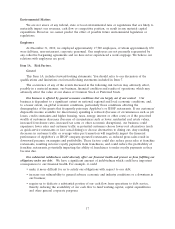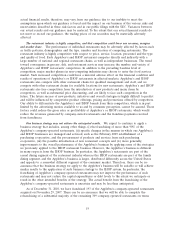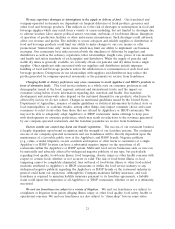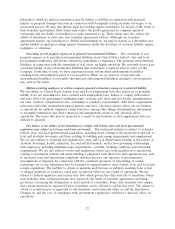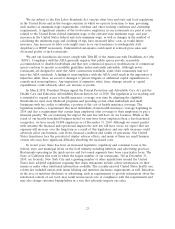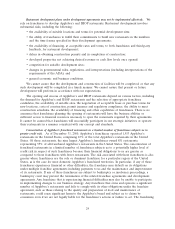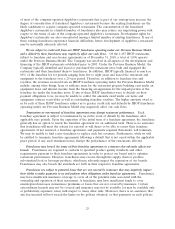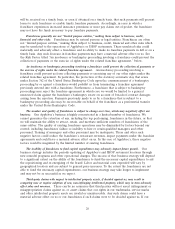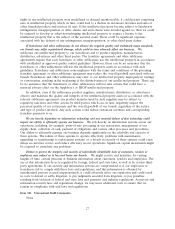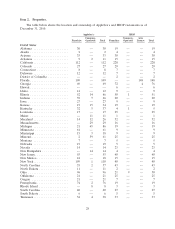IHOP 2010 Annual Report Download - page 34
Download and view the complete annual report
Please find page 34 of the 2010 IHOP annual report below. You can navigate through the pages in the report by either clicking on the pages listed below, or by using the keyword search tool below to find specific information within the annual report.• limit our flexibility in planning for, or reacting to, changes in our business and the industry in
which we operate;
• place us at a competitive disadvantage compared to our competitors that are not as highly
leveraged;
• limit, along with the financial and other restrictive covenants in our indebtedness, among other
things, our ability to borrow additional funds; and
• result in an event of default if we fail to satisfy our obligations under our debt or fail to comply
with the financial and other restrictive covenants contained in our debt documents, which event
of default could result in all of our debt becoming immediately due and payable and could
permit certain of our lenders to foreclose on our assets securing such debt.
In addition, we may incur substantial additional indebtedness in the future. If new debt is added to
our current debt levels, the related risks that we now face could intensify.
To service our indebtedness, we will require a significant amount of cash, which depends on many factors
beyond our control. There is no assurance that our business will generate sufficient cash flow from
operations, or that future borrowings will be available to us under our senior secured credit facility in
amounts sufficient to enable us to fund our liquidity needs, including with respect to our other
indebtedness. As we are required to satisfy amortization requirements under our senior secured credit
facility or as other debt matures, we may also need to raise funds to refinance all or a portion of our
debt when it becomes due. Further, there is no assurance that we will be able to refinance any of our
debt on attractive terms, commercially reasonable terms or at all. Our future operating performance
and our ability to service, extend or refinance our debt will be subject to future economic conditions
and to financial, business and other factors.
Declines in our financial performance could result in additional impairment charges in future periods.
United States generally accepted accounting principles (‘‘U.S. GAAP’’) require annual (or more
frequently if events or changes in circumstances warrant) impairment tests of goodwill, intangible assets
and other long-lived assets. Generally speaking, if the carrying value of the asset is in excess of the
estimated fair value of the asset, the carrying value will be adjusted to fair value through an
impairment charge. Fair values of goodwill and intangible assets are primarily estimated using
discounted cash flows based on five-year forecasts of financial results that incorporate assumptions as
to same-restaurant sales trends, future development plans and brand-enhancing initiatives, among other
things. Fair values of long-lived tangible assets are primarily estimated using discounted cash flows over
the estimated useful lives of the assets. Significant underachievement of forecasted results could reduce
the estimated fair value of these assets below the carrying value, requiring non-cash impairment charges
to reduce the carrying value of the asset. As of December 31, 2010 our total stockholders’ equity was
$83.6 million. A significant impairment write-down of goodwill, intangible assets or long-lived assets in
the future could result in a deficit balance in stockholders’ equity. While such a deficit balance would
not create an incident of default in any of our contractual agreements, the negative perception of such
a deficit could have an adverse effect on our stock price and could impair our ability to obtain new
financing, or refinance existing indebtedness on commercially reasonable terms or at all.
Our actual operating and financial results in any given period may differ from guidance we provide to
the public, including our most recent public guidance. From time to time, in press releases, SEC filings,
public conference calls and other contexts, we have provided guidance to the public regarding current
business conditions and our expectations for our future financial results. We expect that we will provide
guidance periodically in the future. Our guidance is based upon a number of assumptions, expectations
and estimates that are inherently subject to significant business, economic and competitive uncertainties
and contingencies, many of which are beyond our control. In providing our guidance, we also make
various assumptions with respect to our future business decisions, some of which will change. Our
18




